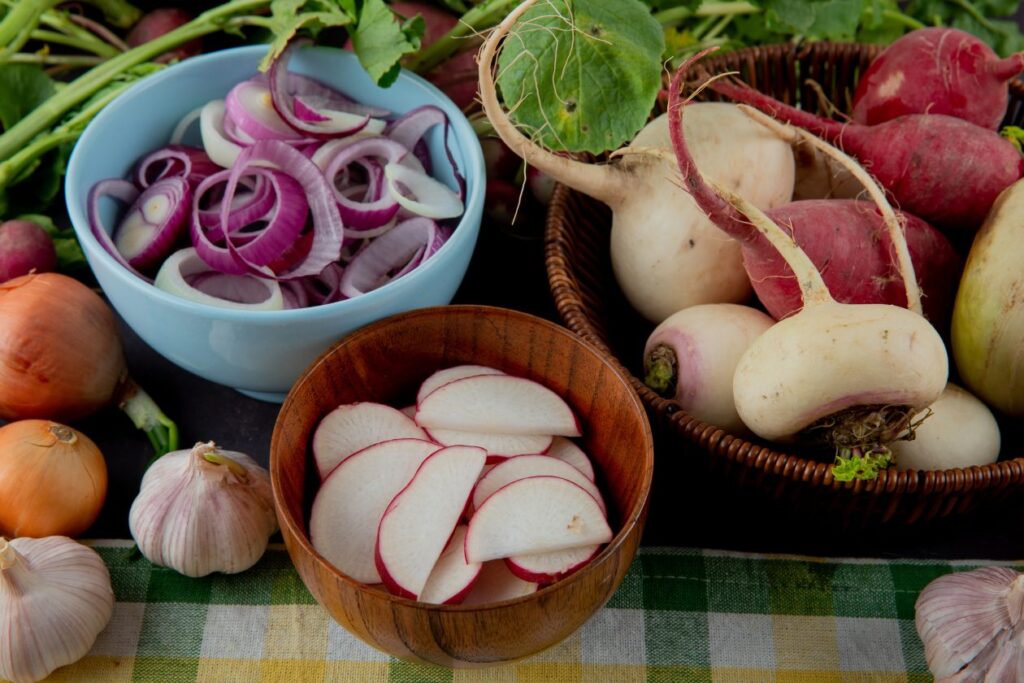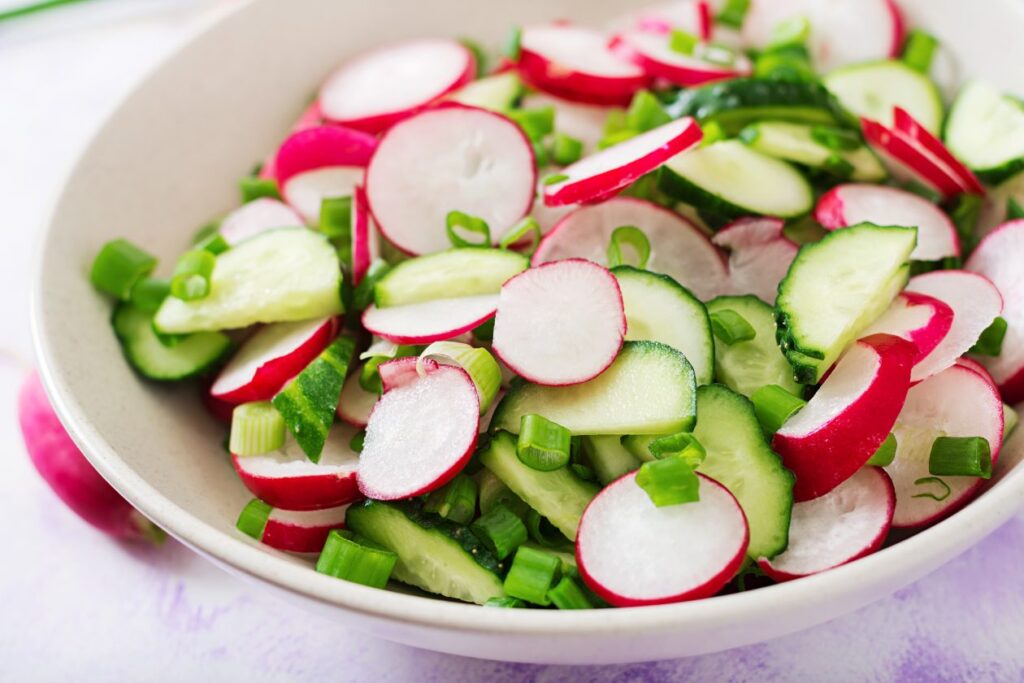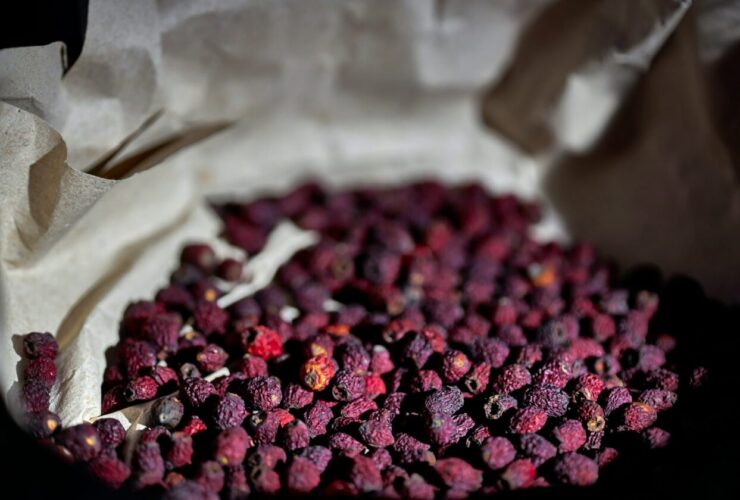Introduction
Root vegetables that are crisp and peppery radishes can be found in various sizes, forms, and colors. They are renowned for their unique flavor profile and crispy texture and are members of the Brassicaceae family. Radishes are a popular addition to salads, pickles, and other food preparations because they are tasty and nutrient-dense.
The ketogenic diet, or the high-fat, low-carb diet, is a metabolic state brought on by eating a diet rich in fat and low in carbs. The keto diet aims to increase weight loss, improve metabolic health, and improve cognitive function by significantly reducing carbohydrate intake and increasing fat consumption. Although eating fats and limiting carbohydrates is the main focus of the keto diet, it’s essential to consider the carbohydrate level of all foods, even vegetables like radishes.
Is it OK to eat radishes while on the keto diet? People who follow this diet plan to consume as little carbohydrates as possible to enter and stay in ketosis. To provide an answer, we must investigate the nutritional value of radishes and their place in the macronutrient profile of the ketogenic diet. Let’s examine radishes’ nutritional makeup in more detail and see whether they work well with a ketogenic diet.
Nutritional Profile of Radishes

Radishes are an excellent option for keto diets because of their well-known low-calorie and low-carbohydrate content. Radishes add a nice crunch without raising blood sugar, as a serving only contains roughly 1 gram of net carbs. Because of this, they may be used in various keto-friendly recipes and snacks, letting people indulge in their favorite foods without exceeding their daily carbohydrate allowance.
Radishes are a remarkable source of many essential nutrients necessary for good health and well-being, even though they contain low calorie and carbohydrate content. They are exceptionally high in vitamin C, a potent antioxidant that boosts collagen synthesis and the immune system. Radishes also contain various B vitamins vital for energy metabolism, cellular health, and potassium. This electrolyte is essential for preserving fluid balance and neuronal function. Radishes can guarantee appropriate intake of these crucial elements when included in a ketogenic diet.
The high fiber and antioxidant content of radishes is another noteworthy feature. Fiber helps maintain regular bowel movements and keeps constipation at bay, essential for digestive health. Additionally, radishes include antioxidants like anthocyanins and flavonoids that help fight inflammation and oxidative stress, which lowers the risk of chronic illnesses like cancer and heart disease. People can maintain their keto lifestyle by including radishes while reaping these health benefits.
In summary, radishes complement a ketogenic diet greatly since they are low in calories and carbohydrates yet high in fiber, antioxidants, and other essential minerals. Radishes are a tasty and nutritious method to maintain general health when in ketosis, whether eaten raw as a crisp snack or added to salads, soups, or side dishes.
Health Benefits of Radishes

Radishes have a unique benefit for those on the ketogenic diet since they can help with blood sugar regulation. Radishes are a good food choice for people trying to stay in ketosis because of their high fiber content and low carbohydrate content, which have a minimal effect on blood glucose levels. The fiber in radishes helps people remain within their intended carbohydrate limitations by delaying the rate at which carbohydrates enter the system and causing insulin spikes. Because of this characteristic, radishes provide flavor and nutritional value to keto-friendly meals and snacks without sacrificing metabolic goals.
Radishes enhance liver function and detoxification in addition to their role in blood sugar regulation. Studies indicate that substances in radishes may assist in increasing the activity of liver enzymes, supporting the body’s natural detoxification activities. Radishes help the objectives of those who pursue a ketogenic diet by adding to overall metabolic performance and improving nutrient utilization by promoting liver health. Thus, adding radishes to meals can have various advantages for detoxification and metabolic health.
Radishes complement a diet that prevents cancer because of their antioxidant and phytochemical content, which may contribute to their possible anticancer effects. These substances lessen oxidative stress and inflammation connected to cancer development by scavenging dangerous free radicals. Furthermore, radishes contain several phytochemicals that have been shown to suppress the growth of cancer cells and encourage apoptosis or programmed cell death. Radishes may protect against several cancers, but further research is necessary to fully understand the processes underlying these effects. A varied and balanced diet should include radishes.
Radishes also improve cardiovascular and gastrointestinal health by promoting healthy digestion and lowering blood pressure. Because potassium balances sodium levels and encourages vasodilation, which relaxes blood vessels and lessens cardiac strain, radishes’ potassium content helps control blood pressure. Furthermore, radishes’ high fiber and water content promote regularity and hydration in the digestive system, which helps to avoid constipation and promotes the best possible absorption of nutrients. Thus, adding radishes to meals can promote a holistic approach to health that considers digestive and cardiovascular health.
In conclusion, radishes provide several health advantages consistent with the keto diet’s tenets. Radishes are:
- A versatile and healthy addition to any keto-friendly diet plan.
- Thanks to their anticancer characteristics.
- Support for liver function.
- Capacity to help with blood sugar management.
They also promote digestive and cardiovascular health. People can take advantage of radishes’ many health benefits and enjoy their distinct flavor by including them in a varied and well-balanced diet.
Types of Radishes
Radishes are available in various sizes, shapes, and colors; typical types include daikon, black, and red radishes. Because they each have a unique nutritional makeup and flavor profile, these components are used in various cuisines worldwide. Red radishes are widely accessible and frequently used in salads, sandwiches, and garnishes. They are noted for their peppery taste and brilliant hue. With their strong taste and darker color, black radishes are highly valued for their possible health advantages and for adding complexity to recipes. With their longer shape and softer flavor, daikon radishes are a common ingredient in Asian soups, stir-fries, and pickles.
Black radishes have a more robust flavor with undertones of earthiness and bitterness, while red radishes are prized for their crisp texture and spicy sting. Conversely, daikon radishes have a mellow, slightly sweet flavor that works well in cooked and raw recipes. All radishes have similar nutritional qualities despite having different flavors. They are high in vital minerals, including potassium, vitamin C, and several B vitamins, but low in calories and carbs. Regardless of their color or shape, radishes also contain antioxidants and phytochemicals that add to their health-promoting qualities.
Apart from the popular types, there is a wide variety of heirloom radishes, such as watermelon, French breakfast, and Easter egg radishes. Named for the bright pink insides that resemble the fruit, watermelon radishes taste mildly spicy but are visually appealing on salads and crudité platters. Long and white at the tip, French breakfast radishes have a crisp texture and mild flavor, making them perfect for nibbling or serving with bread and cheese. Easter egg radishes have a mild taste with a sweetness and come in various colors, including pink, purple, and white. For those daring with their food, these heritage cultivars offer exceptional flavor profiles highlighting the radishes’ great diversity.
Incorporating Radishes into a Keto Diet

Radishes are a great low-carb alternative for those on a ketogenic diet, especially when eaten raw in salads. Their peppery flavor and crisp texture give salads more depth without dramatically raising the amount of carbohydrates consumed. When radishes are combined with leafy greens like spinach or arugula and keto-friendly toppings like avocado and almonds, a filling and healthy dinner that adheres to ketogenic principles is produced. Furthermore, the high fiber of radishes adds to feelings of fullness, making them a great addition to keto salads for encouraging satiety and aiding with weight management objectives.
Radishes can be used in a variety of ways to complement a ketogenic diet and increase their shelf life by pickling them. Pickled radishes provide a pleasant counterpoint to rich and savory keto recipes because they maintain their crisp and sour flavor. Radishes are pickled by immersing them in a vinegar-based solution flavored with herbs and spices, which improves their flavor and keeps them crisp. Eat pickled radishes as a spicy garnish for keto burgers, tacos, or grilled meats to give your food a complex and acidic kick without breaking your ketosis.
Radishes become flavorful and texture-rich when roasted or sautéed, providing a cozy and satisfying substitute for eating them raw. Radish tastes more mellow and caramelized when cooked, so it’s a better option for people who find raw radishes too strong. Herbs and spices like garlic, thyme, or rosemary can be added to roasted radishes to enhance a variety of keto recipes, including roasted vegetables and meat-based feasts. Similarly, sautéed radishes make delicious and filling side dishes or toppings for keto-friendly pizzas and omelets when combined with other low-carb items like bacon, onions, and mushrooms.
Apart from the root, radish greens provide dietary advantages and culinary adaptability, which makes them a perfect part of a ketogenic diet. Radish greens are a nutrient-dense complement to keto meals since they are high in vitamins, minerals, and antioxidants. Radish greens can be used in salads, soups, pesto, and stir-fries to improve their flavor and nutritional value. Using the whole radish plant reduces waste and optimizes the nutritional content of this adaptable vegetable, in line with environmentally friendly and health-conscious eating habits. Try various cooking techniques and taste combos to find inventive ways to include radish greens in your keto meal repertoire.
Potential Side Effects and Considerations
Although radishes are all health benefits, eating too many can have negative impacts. The possibility of gastrointestinal distress, such as bloating and gas, is one main worry, mainly when consumed in significant amounts. Furthermore, eating too many radishes can cause dehydration because of their diuretic qualities, especially if sufficient fluid intake is not kept up. Radishes should be included in your diet in moderation to reduce the likelihood of these adverse effects and support the health of your digestive system.
While rare, allergic responses to radishes can happen to certain people, especially if they are already sensitive to cruciferous vegetables or specific proteins in radishes. An allergy to radish can include swelling, hives, itching, and breathing difficulties. When adding radishes to your diet, proceed cautiously if you have a known allergy to related veggies like broccoli or cabbage. Seek medical advice if you suffer any adverse reactions. It is essential to carefully read food labels and exercise caution when preparing food, just like any other food allergy.
Radishes can be a part of any diet, keto or otherwise, but moderation is the key when including them. Although radishes are safe and have many benefits, tolerance levels can vary. Radishes have glucosinolates that contain sulfur, which some people may be more sensitive to. This could explain why radishes have a unique taste and possibly even have health benefits. Pay attention to your body’s signals and modify your radish consumption according to your dietary preferences and tolerances. For individualized nutritional advice, speak with a healthcare professional or registered dietitian if you have any underlying medical conditions or concerns.
Are Radishes Keto Friendly?
A. Short Answer: Radishes can be included in a keto diet due to their low-carb content and beneficial nutritional profile.
B. In-Depth Analysis: Radishes are keto-friendly vegetables that can be incorporated into a low-carb, high-fat diet. With their low-calorie and low-carb nature, radishes are an excellent addition to keto meals. They are rich in essential nutrients such as vitamin C, potassium, and various B vitamins, making them nutritious for those following a ketogenic lifestyle. Moreover, radishes contain high fiber and antioxidants, contributing to their health-promoting properties. These attributes make radishes a suitable option for individuals looking to maintain ketosis while enjoying a diverse range of foods.
In addition to their nutritional value, radishes offer versatility in cooking, allowing for creative and delicious keto-friendly dishes. Whether enjoyed raw in salads, pickled for added flavor, or roasted to enhance their natural sweetness, radishes can add depth and variety to keto meal plans. Furthermore, radish greens, often overlooked, are nutritious and can be incorporated into recipes or used as a salad ingredient, providing additional health benefits. When consuming radishes on a keto diet, it’s essential to consider factors such as portion size, overall carb intake, and individual dietary preferences to ensure they align with personal health goals and preferences.
While radishes are keto-friendly and offer numerous health benefits, a well-rounded ketogenic diet can enhance variety and nutrition. By understanding their nutritional content and exploring creative ways to incorporate them into meals, individuals can enjoy the flavors and benefits of radishes while staying on track with their keto lifestyle. As with any dietary choice, moderation and individual tolerance should be considered to optimize health outcomes and satisfaction on a keto diet.
FAQ about Keto-Friendly Vegetables
Q: Is a radish keto-friendly?
A: Radishes are keto-friendly due to their low-carb content and beneficial nutritional profile.
Q: Are radishes high in carbohydrates?
A: No, radishes are low in carbohydrates, making them suitable for keto diets.
Q: What veggies are unlimited on keto?
A: Non-starchy vegetables such as leafy greens (spinach, kale, lettuce), cruciferous vegetables (broccoli, cauliflower), and other low-carb options like radishes can typically be consumed in unlimited quantities on a keto diet.
Q: Is Labanos keto-friendly?
A: Yes, Labanos, known as daikon radish, is keto-friendly due to its low-carb content.
Q: Is cucumber OK in keto?
A: Cucumbers are keto-friendly vegetables with a low-carb content, making them suitable for inclusion in keto meal plans.
Q: Is carrot OK for keto?
A: Carrots are higher in carbohydrates than other keto-friendly vegetables and should be consumed in moderation on a ketogenic diet.
Q: Is onion a keto?
A: Onions are higher in carbohydrates and should be consumed in limited quantities on a keto diet, considering daily carb intake.
Q: Is hummus good for keto?
A: Traditional hummus, made from chickpeas, is higher in carbohydrates and may not be suitable for strict keto diets. However, alternatives like avocado or eggplant-based hummus can be lower in carbs and may fit into a keto meal plan in moderation.
Q: Are salads keto?
A: Salads can be keto-friendly, depending on the ingredients used. Opt for leafy greens, low-carb vegetables like cucumber and radishes, healthy fats, and protein sources like grilled chicken or salmon to create a satisfying and nutritious keto-friendly salad.
Q: Can I have lettuce on keto?
A: Lettuce is a keto-friendly vegetable low in carbohydrates and can be included in ketogenic meal plans.
Q: Is radish carb-free?
A: While radishes are low in carbohydrates, they are not entirely carb-free. However, they contain minimal carbs, making them suitable for keto diets.
Q: Can I eat beans on keto?
A: Beans are higher in carbohydrates and may not be suitable for strict keto diets. However, some individuals following a less restrictive approach to keto may include small portions of beans occasionally, considering their overall carb intake for the day.
Conclusion
Finally, radishes are adaptable and nutrient-dense additions to a ketogenic diet, providing many health advantages and balancing low-carb meal plans wonderfully. Radishes offer a beneficial nutritional boost without sacrificing ketogenic principles, thanks to their low calorie and low carbohydrate content and a broad array of critical nutrients, including potassium, vitamin C, and B vitamins. Furthermore, research indicates that radishes may help regulate blood sugar, promote liver health, and have anticancer qualities, which makes them a good option for anyone following a ketogenic diet.
Radishes are an excellent choice for people who want to stay in ketosis but still enjoy a variety of tastes and textures in their meals, proving that they are keto-friendly. Radishes are a satiating and healthy substitute for higher-carb veggies due to their little effect on blood sugar levels and capacity to increase satiety. Radishes are a crisp and tasty root vegetable that may provide variety to a diet while providing a host of health advantages when included in keto meal plans.
I urge readers to think of inventive ways to include radishes in their keto meal repertoire because of their nutritional worth and friendliness. Raw in salads, pickled for extra flavor, or roasted to bring out their inherent sweetness, radishes are a versatile ingredient that may improve ketogenic recipes’ flavor and nutritional value. Keto meals may be more exciting and flavorful by experimenting with different radish kinds and cooking techniques, making the journey toward optimal health gratifying and pleasurable.
Reference
Lee, S. W., Yang, K. M., Kim, J. K., Nam, B. H., Lee, C. M., Jeong, M. H., Seo, S. Y., Kim, G. Y., & Jo, S. (2012). Effects of White Radish (Raphanus sativus) Enzyme Extract on Hepatotoxicity. Toxicological Research, 28(3), 165-172. https://doi.org/10.5487/TR.2012.28.3.165
(1) U.S. DEPARTMENT OF AGRICULTURE – Radishes, raw
https://fdc.nal.usda.gov/fdc-app.html#/food-details/169276/nutrients
(2) Are Radishes Good for You? – Healthline
https://www.healthline.com/health/food-nutrition/the-benefits-of-radishes
(3) The 21 Best Low-Carb Vegetables – Healthline
https://www.healthline.com/nutrition/21-best-low-carb-vegetables
(4) The Nutrients in Radishes – Healthy Eating | SF Gate
https://healthyeating.sfgate.com/nutrients-radishes-4369.html
(5) Are Radishes Good for You? – Healthline
https://www.healthline.com/health/food-nutrition/the-benefits-of-radishes
(6) Radish: Health Benefits, Nutrition, and Uses – WebMD
https://www.webmd.com/diet/health-benefits-radish
(7) For Diabetics, this root vegetable will help manage blood sugar levels
https://indianexpress.com/article/lifestyle/health/radishes-health-benefits-control-blood-pressure-anti-cancerous-manage-diabetes-8222643/
(8) Radish For Weight Loss: Eating This Low-Calorie Winter
https://food.ndtv.com/food-drinks/radish-for-weight-loss-eating-this-low-calorie-winter-veggie-may-help-you-shed-kilos-1954098
Was this helpful?

Joseph Emb, RDN
Founder of StyleVitally.com | Registered Dietitian & Wellness Advocate
What I Cover:
I’m passionate about connecting nutrition science and everyday wellness to help people live healthier, more vibrant lives. I write about evidence-based nutrition, mindful eating, sustainable lifestyles, and holistic well-being at StyleVitally.com.
My Background:
The University of Texas in Austin, where I earned my Dietetics diploma, laid the groundwork for my nutrition and health career. My training and hands-on experience taught me the science and art of using nutrition to enhance health and well-being.
Professional Journey:
I’m an RDN with lots of experience. I’ve helped people seeking tailored nutritional recommendations in clinical settings and community outreach programs. My constant learning and professional development ensure that my recommendations are always based on the latest evidence.
Ethical Commitment:
My practice prioritizes integrity. My content is transparent and objective, following the most significant ethical standards. I can give my audience unbiased advice because I’m not affiliated with food businesses or industry associations. I want to help people make informed health decisions that match their values and ambitions.
Join Me on the Wellness Journey:
Join me on the path to vitality and well-being, whether facing nutritional issues, seeking sustainable lifestyle changes, or simply wanting a better, happier you. We’ll discover how diet, mindfulness, and holistic well-being can maximize your potential.









